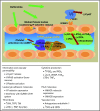The use of defibrotide in blood and marrow transplantation
- PMID: 29945939
- PMCID: PMC6020812
- DOI: 10.1182/bloodadvances.2017008375
The use of defibrotide in blood and marrow transplantation
Erratum in
-
Richardson PG, Carreras E, Iacobelli M, Nejadnik B. The use of defibrotide in blood and marrow transplantation. Blood Adv. 2018;2(12):1495-1509.Blood Adv. 2018 Aug 14;2(15):1853. doi: 10.1182/bloodadvances.2018023168. Blood Adv. 2018. PMID: 30061309 Free PMC article. No abstract available.
Abstract
Hepatic veno-occlusive disease/sinusoidal obstruction syndrome (VOD/SOS) is a potentially life-threatening complication of conditioning during hematopoietic stem cell transplantation (HSCT) or chemotherapy without HSCT, with a historically reported mean incidence of 13.7% post-HSCT. Typical symptoms of VOD/SOS may include hyperbilirubinemia, painful hepatomegaly, weight gain, and ascites. Defibrotide, a polydisperse mixture of predominantly single-stranded polydeoxyribonucleotides, is currently the only therapy approved to treat hepatic VOD/SOS with pulmonary/renal dysfunction (ie, multiorgan dysfunction/multiorgan failure [MOD/MOF]) following HSCT in the United States and to treat severe hepatic VOD/SOS post-HSCT in the European Union. In preclinical and human studies, defibrotide has demonstrated profibrinolytic, antithrombotic, anti-inflammatory, and angio-protective actions, thus promoting an anticoagulant phenotype of the endothelium that protects and stabilizes the function of endothelial cells. In a phase 3, historically controlled, multicenter trial in adults and children with VOD/SOS and MOD/MOF (defibrotide: n = 102; controls treated before defibrotide availability: n = 32), defibrotide resulted in significantly greater day +100 survival following HSCT (38.2%) vs controls (25.0%; propensity analysis-estimated between-group difference: 23%; P = .0109). The most common adverse events (AEs) were hypotension and diarrhea; rates of common hemorrhagic AEs were similar in the defibrotide and historical control group (64% and 75%, respectively). In a phase 3 prophylaxis trial, defibrotide was found to lower incidence of VOD/SOS in children (not an approved indication) and reduce the incidence of graft-versus-host disease. This review describes the development and clinical applications of defibrotide, focusing on its on-label use in patients with VOD/SOS and MOD/MOF after HSCT.
© 2018 by The American Society of Hematology.
Conflict of interest statement
Conflict-of-interest disclosure: P.G.R. has served on advisory committees and received research funding from Jazz Pharmaceuticals. E.C. has served on advisory boards and the speakers bureau for, received research funding from, and provided expert testimony for Gentium. M.I. was formerly an employee of Gentium. B.N. was formerly an employee of Jazz Pharmaceuticals; in the course of employment, he received stock options exercisable for, and other stock awards of, ordinary shares of Jazz Pharmaceuticals plc.
Figures



Similar articles
-
Defibrotide for Patients with Hepatic Veno-Occlusive Disease/Sinusoidal Obstruction Syndrome: Interim Results from a Treatment IND Study.Biol Blood Marrow Transplant. 2017 Jun;23(6):997-1004. doi: 10.1016/j.bbmt.2017.03.008. Epub 2017 Mar 8. Biol Blood Marrow Transplant. 2017. PMID: 28285079
-
Defibrotide for children and adults with hepatic veno-occlusive disease post hematopoietic cell transplantation.Expert Rev Gastroenterol Hepatol. 2017 Oct;11(10):885-898. doi: 10.1080/17474124.2017.1370372. Epub 2017 Sep 4. Expert Rev Gastroenterol Hepatol. 2017. PMID: 28825848
-
Defibrotide sodium for the treatment of hepatic veno-occlusive disease/sinusoidal obstruction syndrome.Expert Rev Clin Pharmacol. 2018 Feb;11(2):113-124. doi: 10.1080/17512433.2018.1421943. Epub 2018 Jan 5. Expert Rev Clin Pharmacol. 2018. PMID: 29301447 Review.
-
Defibrotide for the treatment of hepatic veno-occlusive disease/sinusoidal obstruction syndrome following nontransplant-associated chemotherapy: Final results from a post hoc analysis of data from an expanded-access program.Pediatr Blood Cancer. 2018 Oct;65(10):e27269. doi: 10.1002/pbc.27269. Epub 2018 Jun 6. Pediatr Blood Cancer. 2018. PMID: 29873895 Free PMC article. Clinical Trial.
-
Hepatic veno-occlusive disease after hematopoietic stem cell transplantation: update on defibrotide and other current investigational therapies.Bone Marrow Transplant. 2008 Feb;41(3):229-37. doi: 10.1038/sj.bmt.1705899. Epub 2007 Nov 12. Bone Marrow Transplant. 2008. PMID: 17994121 Review.
Cited by
-
Is the Endothelium the Missing Link in the Pathophysiology and Treatment of COVID-19 Complications?Cardiovasc Drugs Ther. 2022 Jun;36(3):547-560. doi: 10.1007/s10557-021-07207-w. Epub 2021 Jun 7. Cardiovasc Drugs Ther. 2022. PMID: 34097193 Free PMC article. Review.
-
Endothelial dysfunction and its critical role in COVID-19-associated coagulopathy: Defibrotide as an endothelium-protective, targeted therapy.EJHaem. 2021 Jun 22;2(3):680-681. doi: 10.1002/jha2.198. eCollection 2021 Aug. EJHaem. 2021. PMID: 34518829 Free PMC article. No abstract available.
-
Use of defibrotide in COVID-19 pneumonia: comparison of a phase II study and a matched real-world cohort control.Haematologica. 2024 Oct 1;109(10):3261-3268. doi: 10.3324/haematol.2024.285345. Haematologica. 2024. PMID: 38779740 Free PMC article. Clinical Trial.
-
Operational procedure sharing pathway in veno-occlusive disease: a Delphi consensus-based recommendations.Front Oncol. 2025 Mar 12;15:1498782. doi: 10.3389/fonc.2025.1498782. eCollection 2025. Front Oncol. 2025. PMID: 40144213 Free PMC article.
-
Biomarkers for Early Complications of Endothelial Origin After Allogeneic Hematopoietic Stem Cell Transplantation: Do They Have a Potential Clinical Role?Front Immunol. 2021 May 19;12:641427. doi: 10.3389/fimmu.2021.641427. eCollection 2021. Front Immunol. 2021. PMID: 34093530 Free PMC article. Review.
References
-
- Gentium SA. Executive informational overview. http://cdn2.hubspot.net/hub/150154/file-18094943-pdf/docs/gent_eio_06-26.... Accessed 12 September 2017.
-
- Pescador R, Capuzzi L, Mantovani M, Fulgenzi A, Ferrero ME. Defibrotide: properties and clinical use of an old/new drug. Vascul Pharmacol. 2013;59(1-2):1-10. - PubMed
-
- Niada R, Mantovani M, Prino G, et al. Antithrombotic activity of a polydeoxyribonucleotidic substance extracted from mammalian organs: a possible link with prostacyclin. Thromb Res. 1981;23(3):233-246. - PubMed
-
- Falanga A, Vignoli A, Marchetti M, Barbui T. Defibrotide reduces procoagulant activity and increases fibrinolytic properties of endothelial cells. Leukemia. 2003;17(8):1636-1642. - PubMed
-
- Echart CL, Graziadio B, Somaini S, et al. The fibrinolytic mechanism of defibrotide: effect of defibrotide on plasmin activity. Blood Coagul Fibrinolysis. 2009;20(8):627-634. - PubMed
Publication types
MeSH terms
Substances
LinkOut - more resources
Full Text Sources
Other Literature Sources
Medical

